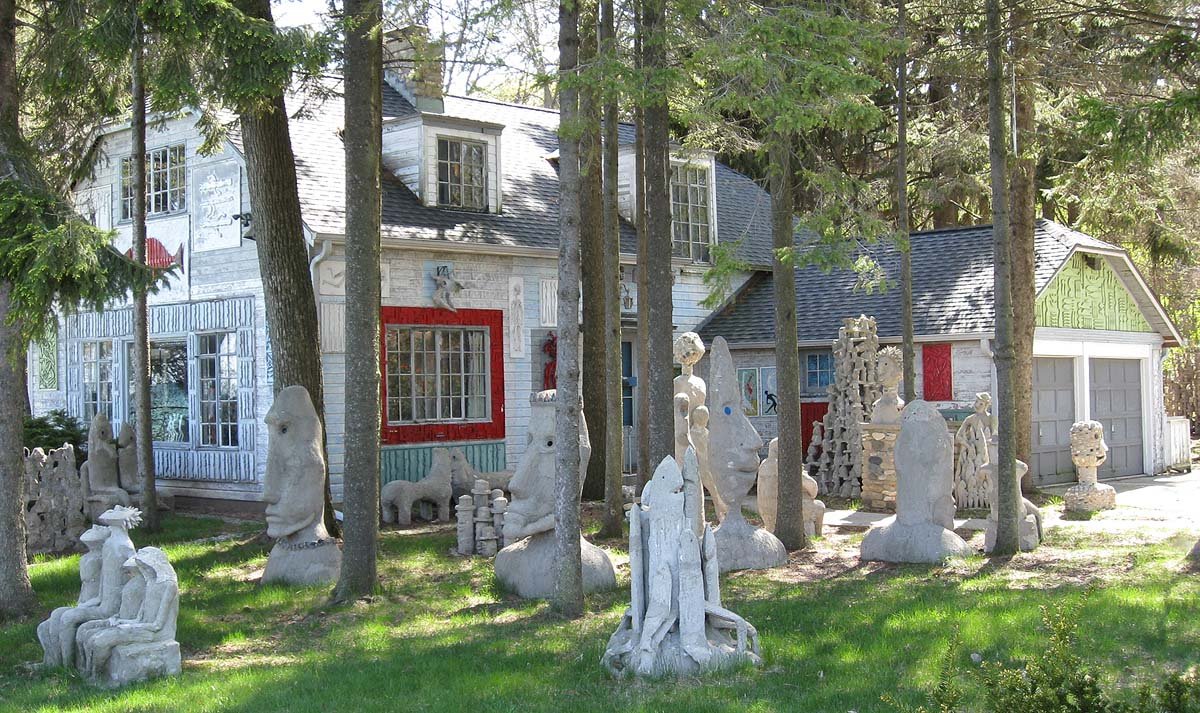10 Historical Facts About Fox Point, Wisconsin
Mary Nohl house photo by Kevin Hansen
Home to the famous “Witch House” and Wisconsin’s first licensed female architect, Fox Point combines artistic legacy with architectural innovation. This elegant lakefront community has evolved from Dutch farming settlement to exclusive suburb while maintaining its distinctive character and producing some of Wisconsin’s most unique cultural contributions.
1. The “Witch of Fox Point”
Mary Nohl (1914-2001) transformed her Fox Point lakefront home into one of America’s most remarkable art environments, earning her the nickname “Witch of Fox Point.” A professionally trained artist from the Art Institute of Chicago, Nohl created over 60 sculptures of concrete, glass, and stone throughout her property, including a 12-foot grinning dinosaur sculpture and thousands of interior artworks. Her artistic vision was so striking that the Violent Femmes used her garden as the location for their 1984 “Hallowed Ground” album cover.
2. National Register of Historic Places Recognition
After Mary Nohl’s death in 2001, neighborhood residents who considered the site an eyesore tried to have it demolished. However, in 2005, the property was placed on the National Register of Historic Places. The National Register record calls the Mary Nohl Art Environment “one of Wisconsin’s most original and outstanding works of art.” When she died, her estate of over $11 million went to the Greater Milwaukee Foundation.
3. Wisconsin’s First Licensed Female Architect
Lillian Leenhouts (right) receiving a Fellow certificate at the 1980 Society of Women Engineers National Convention- Courtesy of the Walter P. Reuther Library, Wayne State University
Fox Point claims architectural history through the Friedlander Residence (1952), designed by Lillian Leenhouts, the first woman licensed to practice architecture in Wisconsin. Her modernist approach with regional sensitivities helped establish Fox Point’s reputation for architectural innovation. The residence typifies the simple, unpretentious ranch houses the couple designed throughout the North Shore.
4. Dutch Settlement Origins
Most of the early Fox Point settlers were Dutch immigrants. Joel Buttles was the first white person to settle in Fox Point, purchasing 560 acres of land in what is now Fox Point, River Hills, Shorewood, and Whitefish Bay in 1843. There were few Native Americans in the area because the soil was thick with clay, making farming difficult. Other Dutch settlers followed and used new agricultural techniques to grow wheat, barley, rye, and corn despite the challenging conditions.
5. The Fox Point Name Origin
The community got its name from a distinctive geographic feature. Some residents noticed that a point of land (in what is now Doctors Park) that jutted into Lake Michigan looked like the head or nose of a fox, so they named the area “Foxes Point.” Eventually, the name was shortened to “Fox Point.” This natural landmark continues to define the community’s identity.
6. Summer Home Settlement of the 1890s
The second major settlement wave began in the 1890s when wealthy Milwaukeeans built summer homes in Fox Point. They also established the Fox Point Club, a private club where members could golf, boat, swim, or attend parties and balls. Being a rural area at the time, there was no electricity, running water, sewage, or garbage collection.
7. Strategic 1926 Incorporation
By the 1920s, Fox Point residents expected better services than the Town of Milwaukee was providing. The community incorporated as a village in 1926 to gain control over municipal services and development. The Fox Point School District began operating the following year, establishing local control over education.
8. The Old Dutch Schoolhouse Heritage
The Old Dutch Schoolhouse is a hewn-log structure erected in winter 1853-54 by School District No. 9 in the Township of Milwaukee. The building was used for public meetings and church services by the Reformed Church of Bethlehem, a Dutch Reformed congregation. The adjoining tract was deeded to the congregation for cemetery purposes in 1868, though grave markers indicate burials had taken place as early as 1854.
9. Historic Bus Station Architecture
Fox Point maintains four historic bus stations along Lake Drive, built between 1937 and 1963. These structures were designed to “blend in” with the green, residential community and were described in early 1920s Calumet Land Company advertisements as part of “one large, beautiful park.” The Bell Road bus station (1940) was designated as a landmark for its uniqueness and essential mark of community character.
10. North Shore Independence Alliance
In 1954, Fox Point joined with representatives from Bayside, Glendale, and River Hills in a crucial meeting to annex what remained of the Town of Milwaukee. This cooperative effort successfully prevented the City of Milwaukee’s eastward expansion and preserved the independence of all four North Shore communities. This strategic alliance demonstrated how the villages worked together to maintain their distinct identities and local control while resisting urban annexation pressures.
Today’s Fox Point continues to balance its artistic legacy with residential elegance, maintaining its character as a planned community where natural beauty, architectural innovation, and cultural significance create a unique North Shore experience. The ongoing preservation of Mary Nohl’s art environment ensures that Fox Point’s most distinctive cultural contribution will continue to inspire future generations.





For those in the North Shore area planning their holiday schedule, here is a verified guide to 2025 Christmas services in and around Fox Point, Wisconsin. Whether you are looking for a traditional liturgical mass or a casual family-focused service, these local congregations offer several options for Christmas Eve and Christmas Day.